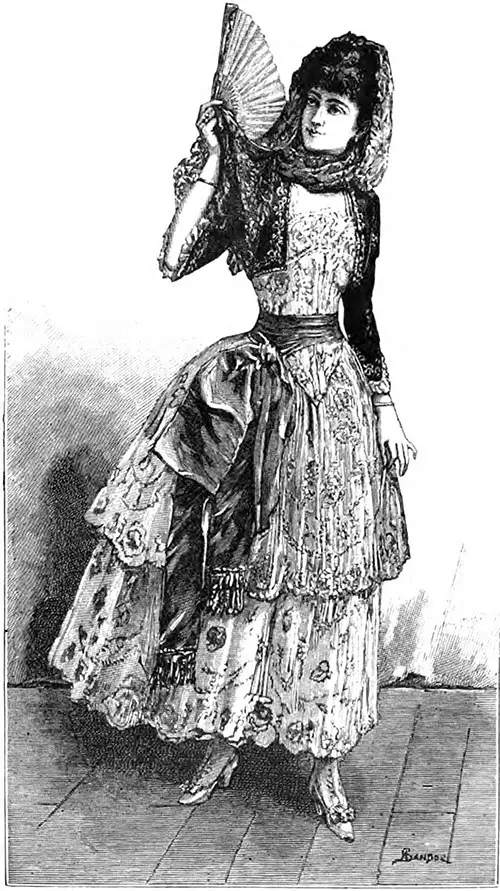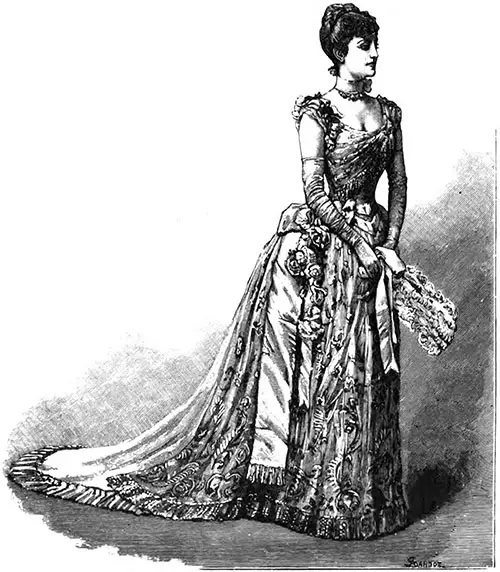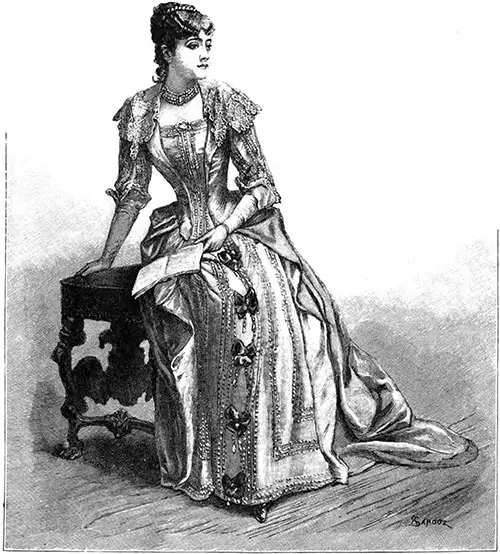Paris Fashions March 1888
Short dresses are the order of the day and of the evening. All the dainty Parisiennes have adopted this fashion, which is the more remarkable, seeing that the French season has begun early with what we are pleased to call "serious festivities."
A dance, improvised by some good fairy friend of the mistress of the house for the benefit of the young folk, it is true, usually follows the concert, the literary discussion, the comedy organized for the elder members of the community, who prefer to take their pleasures sitting.
The dance-loving Parisian women have decreed, in that mysterious conclave from which emanate the fashions ruling the civilized world, that as there is nothing more delightfully irresponsible to wear in a crush than short skirts, and nothing more damping to high spirits than the care of a train on such occasions, curtailed petticoats are to be worn.
The thought of the perils to which their sweeping draperies are exposed oppresses many feminine souls in the press of arrival, in the compact throng around the buffet. The men behave with masculine indifference towards clothes.
They trample upon trains as they come and go, intent upon serving the fair ones whose dresses they are ruining, upsetting strop, spilling pedis fours and sandwiches, as they stumble along with feet entangled in the confusion of draperies spread over the floor, impeding their free passage.
Our grandes dames, however, are making a stand against this invasion of short skirts in the domain of gala gatherings and refuse to lay aside the straight and amply-flowing train, the majestic grace of which can be supplied by no other fashion.
The train reminds these Frenchwomen of the courtly days of yore. The elegant manners, the distinction of costume at once splendid and coquettish, which belonged then by right to high-born ladies, are all still suggested by these flowing draperies, which are part of the traditional costume of a feminine aristocracy.
A Royal Highness, a Princess of the blood would appear shorn of half her state were she to wear a short dress at a courtly pageant. Marie Antoinette playing tin' part of milkmaid in the garden of Trianon by assuming a peasant's dress, aimed it may be an unconscious blow at Majesty.
It is not for us to discuss here if Queens by neglecting costume, or by treating the claims of apparel too lightly, do not help to undermine the dignity of the Crown.
We would simply protest in the name of art against the threatened abuse of short skirts, and the suppression of trains for costumes, the regal style of which cannot be attained without length and flow of line.
Our grandes dames leave therefore to young women and to indefatigable dancers the monopoly of curtailed skirts, but short gowns are never worn by the Duchesse de Doudeauville, nor by the Princesse de Sagan, nor by the Princess Jouriensky, nor by any of those hostesses who, though young still, are nevertheless not newly married, and who by their social position head the fashionable movement and maintain there the ghost of a past elegance.
The wives of ambassadors in Republican Paris, as in London, Vienna, Berlin, justly preserve even in minute details the state of their respective Courts. It is for one of these ladies, proxies of Royalty, that the Maison Corbay Wenzel has just completed a magnificent costume of glowworm-green lampas.
The front, draped in Louis XVI style, is mounted in fan-shaped pleatings upon a plain skirt reversed at one side. Each fold gleams with a crystallized shower of pearly drops. The skirt and train are wreathed with roses. The front of the low bodice is also garlanded with roses glistening with crystal drops.
Another dress to be worn by one of these ladies representing Royalty is of white watered silk, made with a long train. The skirt, which is open in front and fastened back by clusters of feathers, discloses a petticoat tied with gauze ribbon embroidered in pearls.
Another kingdom, that of the stage, has also undergone the invasion of short skirts. Our artists knowing how much grace and elegance they would lose by laying aside their sweeping draperies and knowing on the other hand how hampered they are by long trains, they have affected a compromise by adopting the demi-train for theatrical costumes.

Mme. Patti in 'Le Babbier‘
The forty-five dresses prepared by Mmes. Morin Blossier for Adelina Patti are mostly made with demi-trains. Never was plumage of singing bird worthier of the sweet-voiced charmer than are these brilliant costumes destined for the apparel of the Diva during her American tour and her visit to Madrid and Lisbon.
It was particularly necessary that Adelina Patti, whose lips like those of the heroine of the fairy tale drop jewels, should appear a radiant and scintillating figure before her compatriots as she sang for them the swan notes of her farewell.
A difficulty at the outset threatened to check the attempts of Mmes. Morin Blossier to realize the brilliancy of the costumes they had imagined for the queen of song. Gold and silver tarnish if exposed to the salt sea breeze. No packing can effectually guard these metals from its dimming influence.
The artistic dressmakers overcame the difficulty by the liberal use of Venetian glass beads, flakes of mother-of pearl, opal-tinted crystals, and fine pearls.

Mme. Patti in Evening Concert Dress
Let us select from this royal trousseau and describe, if pen can describe, dresses each one of which is a triumph of the couturiere's art. The only dress of the collection seen in Paris was worn by Mme. Patti at the concert la Diva gave in aid of the French hospital in London. It deserves, however, to be placed in the foremost rank.
Imagine over a slip of pink satin a skirt of creamy silken gauze, painted over with Bowers and birds of rare plumage, enriched with gleams of gold; a fringe of pearls round the hem of the dress, a demi-train of lime-green satin placed to the left.
The back of the bodice composed of lime-green satin, the front of embroidered creamy gauze, fringed with pearls, and girt with a Directoire sash of the same delicate lime-green tint, the long ends knotted on the left side falling to the hem of the skirt.

Mme. Patti in “Lucia”
A dinner-dress worn by Mme. Patti on the occasion of the dinner given to the editor of the Figaro, was a "Princesse redingote" of pink faille open to disclose a folded fichu, transparent sleeves and shirt of embroidered net striped longitudinally with bands of pink watered ribbon; the sash of moss-green velvet.
To speak of Mme. Patti is to recall memories of the piteous story set to music of the " Dame aux Camellias."
A garland of these waxen blossoms set in their heavy leaves encircles the white satin train to be worn with the ball-dress of embroidered net, also wreathed with camellias and spangled and fringed with fine pearls, crystal and silver beads.
Another dress is of net embroidered with forget-me-nots, over a pink satin petticoat. We might almost say a cascade of velvety roses adorns the dress below; on the hip is placed a great cluster of roses, which is repeated on the net bodice.
The white train is embroidered in roses. The waist is bound with a sash of rose-leaf-green velvet, high and pointed on the left side, and turning into a scarf on the right.
What dreamy Eastern splendor is suggested by the costumes for Lacme! The first is a short sleeveless over-dress, or to use the French technical term, fourreau of red Tunisian stuff, heavily embroidered with gold and variegated silks.
Scarves of purple crepe de Chine encrusted with gold are wound over this garment; one of these fastened to the shoulder is brought round the head. The second is white, silver, and gold. The white silver embroidered skirt is draped with gold-embroidered crepe de Chine.
The bodice is scaled with silver. The cloak, of white silk, is lined with silver and fringed with gold. A casque of gold forms the head-dress. The bracelets and necklet are of gems.
From this semi-barbaric glitter we pass to the picturesque costumes designed for Rigoletto. One of these is a long dress of turquoise-blue faille. At the hem of the simple skirt are inserted two bands of blue velvet and two pleats. The bodice is cut square over a guimpe of white gauze outlined by a band of blue velvet.
One of the dresses designed for the part of " Chrispino " is a feast of color. The dress, made in Louis XV style, is of Japanese brocade, the tea-tinted ground embroidered with vivid-hued flowers and birds.
The skirt is looped over a vieux rose satin petticoat, veiled with draperies of embroidered net strewn with gold and fine pearls, and fastened with clusters of pink, blue, and maize feathers; short sleeves of mingled puffs of brocade and glistening net.
A pure and brilliant symphony in white is to be worn in I Puritani—sheeny satin draped with lace, bordered with pearls and silver beads; the skirt made with double panels encrusted with silver and crystal beaded embroidery.
A dazzling effect is produced by the introduction therein of black diamond "nails;" train and bodice are likewise embroidered.
Another wedding dress is to be worn by the unhappy "Lucia di Lammermoor." Less glittering, it is composed of white satin; the front of the skirt is simple; the panels, with crenellated borders, are covered with shimmering embroideries of pearl, silver, and crystal.
The round train is richly edged with embroidery. The bodice is made with a double waistcoat and with the high sleeves of the period, adorned with ropes of pearls.
We had intended to leave off here our gleanings from the Diva's trousseau, and yet one more beautiful pink dress, to be worn by "Linda di Chamouni," calls for description. It is a dress made in Marie Antoinette fashion—of pink satin striped with a delicate design of foliage.
The skirt is trimmed with two deep flounces of net embroidered with pink carnations, the leaves mingled with gold; at the side, a panel of pink crape bouillonné, fastened with knots of pink watered ribbon; the fichu bodice, of embroidered net and pink crape, set between double loops of the same ribbon.
But the dresses are not the sole items that constitute beautiful costume. Our fair Parisians know this well; and, now that spring is not far off, the shops of our famous milliners begin already to show signs of the coming fashions.
Foremost among these is the Maison Virot, whose salons look like a parterre of strange plants, formed of varied bonnets set on their high perches, which might be precocious flowers coming in advance of the more sylvan blossoms.
Small embroidered capotes are all the rage, coquettishly trimmed with tufts of ribbon preceding the tufts of flowers. Here is a charming, wintry bonnet, composed of scarlet velvet, with a Directoire crown embroidered in gold, and surmounted with black plumes.
Another bonnet is entirely formed of gold passementerie, the two half-moon-shaped sections bound together by knots of pale blue ribbon. In the turban, of blue crape, is placed a small aigrette of black feathers.
Here is another pretty head gear of gold net veiled with black crape, embroidered with gold and beetles' wings; round the crown is placed a drapery of tender blue crape, above which rises an airy structure of black net winged with blue aigrettes.
Some delightfully original little bonnets are composed of three pieces of red and the new Tosca green cashmere, all embroidered in silk and gold with palms and Eastern flowers; the border is formed of a triple chain of gold or jet heads mingled with a rosette of black velvet; the strings of black velvet.
By the introduction of the black note our milliners know how to temper and render becoming the most daring combination of color. Here is a corn-colored capote bordered with straw-colored satin enriched with gold; in front a dainty erection of maize net, black crape, and knots of gold, sustains gilt peacock-feathers; the strings are of maize-colored satin.
Another bonnet, in which this touch of black is effectively introduced, is composed of pink faille, the gatherings outlined by Tom Thumb Chantilly lace. The turban, of pink net, is surmounted by an aigrette of black net.
Another little pink bonnet is composed of plush outlined with three rows of gold and silver daisies in braid. A rosette of black faille, on which spring golden ears of corn, and black velvet strings finish off this dainty headgear.
Paris is the land of bonnets, so we do not apologize for lingering in the shops of its most artistic milliners. Here is a creation in the shape of a little capote of glowworm-green satin, veiled with gold net embroidered with gold beads and beetles' wings.
The turban, of gold net, is surmounted by a light aigrette of velvet reeds and golden barley set amid loops of dark green velvet, with strings of the same shade of velvet.
More effective and picturesque is a Directoire bonnet of maize-colored net lightly bouillonné in front, the crown drawn with narrow white-and-gold braid; behind, a spray of yellow roses hides the comb; over it rises a crest of yellow crape.
Three roses lie under the raised border of the bonnet; two aigrettes of eagle's feathers are placed at the side, fastened by arrows of jet; the strings are of black velvet. The spring bonnet will be the Tosca bonnet, of colored straw, lined with velvet, and trimmed with faille ribbon.
Passing from bonnets to jewels, there are new whims in the wearing of gems. The notice of one innovation must suffice. The Louis XVI rivière, of colored gems not surrounded by diamonds, is becoming fashionable.
Emeralds, rubies, sapphires are now alternated with brilliants of comparable size. These rivières are worn sewn on velvet like dog-collars encircling the throat, and they also edge the bodice of the dress, gleaming through a bouillonné of net.
Johnstone, Violette, “March Fashions: Paris,” in The Woman’s World, Cassell & Company, Limited, London, Paris, New York & Melbourne, Volume I, No. 5, March 1888, p. 236-240.
Note: We have edited this text to correct grammatical errors and improve word choice to clarify the article for today’s readers. Changes made are typically minor, and we often left passive text “as is.” Those who need to quote the article directly should verify any changes by reviewing the original material.

